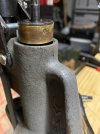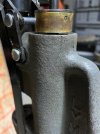oscarflytyer
Well-Known Member
The Lyman 450 I bought/cleaned up/rehab'd a bit has a crack in the press body. Just saw it yesterday when I mounted it. Crack is on the right side, along the lube tube portion of the press - about 1 - 1 1/2" long.
I am assuming 3 possible options. 1) leave it alone; 2) fill the crack with JB Weld/epoxy or the likes - just try to keep it from getting worse; 3) Have it welded - and I DOUBT this will work/assume it won't because the press is cast. But I am not sure.
Open to any ideas or recommendations. Thanx
I am assuming 3 possible options. 1) leave it alone; 2) fill the crack with JB Weld/epoxy or the likes - just try to keep it from getting worse; 3) Have it welded - and I DOUBT this will work/assume it won't because the press is cast. But I am not sure.
Open to any ideas or recommendations. Thanx


